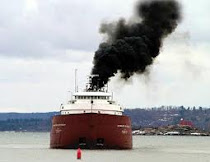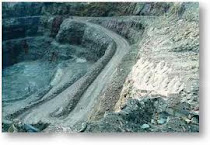Wednesday 27 March 2013
Air Pollution Sources
Air pollution comes from many different sources. Natural processes that affect air quality include volcanoes, which produce sulfur, chlorine, and ash particulates. Wildfires produce smoke and carbon monoxide. Cattle and other animals emit methane as part of their digestive process. Even pine trees emit volatile organic compounds (VOCs).
Many forms of air pollution are human-made. Industrial plants, power plants and vehicles with internal combustion engines produce nitrogen oxides, VOCs, carbon monoxide, carbon dioxide, sulfur dioxide and particulates. In most megacities, such as Mexico City and Los Angeles, cars are the main source of these pollutants. Stoves, incinerators, and farmers burning their crop waste produce carbon monoxide, carbon dioxide, as well as particulates. Other human-made sources include aerosol sprays and leaky refrigerators, as well as fumes from paint, varnish, and other solvents.
One important thing to remember about air pollution is that it doesn’t say in one place. Winds and weather play an important part in transport of pollution locally, regionally, and even around the world, where it affectseverything it comes in contact with.
Leia Mais…
Increase Of Air Pollution
Hot summer days cause in large cities very seldom great happiness among inhabitants. On those days the air is highly polluted with automobile and industrial emissions what makes breathing difficult and unhealthy. According to the latest calculations of Max Planck scientist Dr. Andrea Pozzer this scenario could become true for most of world population in 2050 if no counteractive measures are taken. Especially China, North India and the Middle East are expected to be affected by a drastic decrease in air quality.
In 2050, the air quality in newly industrialized countries and developing countries will be as bad as it already is nowadays in urban areas of Southeast Asia. This is the result of a simulation of the atmosphere done by scientists at the Max Planck Institute for Chemistry, the Institute of Atmospheric Physics and the Joint Research Centre of the European Commission. The chemical atmospheric model EMAC used by the researchers for their current study is the first to include all five major air pollutants known to negatively impact human health: nitrogen dioxide, sulphur dioxide, ozone, carbon monoxide and particulate matter smaller than 2.5 micrometers which are regarded as particularly harmful.
Air pollution is one of the major current health risks of humanity. At present, urban outdoor air pollution causes 1.3 million estimated deaths per year worldwide, according to the World Health Organisation. That number will increase in coming years. Therefor Andrea Pozzer and his colleagues studied the impact of man-made emissions on air quality in different regions of the earth. They show, what could happen if no further action is taken to reduce pollutants.
“Our study shows that further legislation to control and reduce man-made emissions is needed, in particular for eastern China and northern India, to avoid hot-spots of elevated air pollution," says Andrea Pozzer of the Max Planck Institute for Chemistry in Mainz, whose latest research findings are published in the current issue of ‘Atmospheric Chemistry and Physics’, a journal of the European Geosciences Union. According to the results of this study eastern China and northern India are the places that are struggling with the highest pollution levels.
East Asia will be exposed to high levels of pollutants, such as nitrogen dioxide, sulphur dioxide and fine particulate matter (PM2.5). Northern India and the Arabian Gulf region, on the other hand, will suffer a marked increase in ozone levels. This is primarily due to population density and the expected increase in industrial production and transport in these areas. Air pollution in Europe and North America would also increase, but due to the effect of mitigation policies – that have been in place for over two decades now – to a much lesser extent than in Asia.
Pozzer and his colleagues studied the impact of man-made emissions on air quality, assuming past emission trends continue and no additional climate change and air pollution reduction measures beyond what is in place since 2005 are implemented. While pessimistic, the global emissions trends indicate such continuation.
Subsequent to these results the researchers want to broaden the analyses. In the near future they want to calculate how many people would actually be affected by the harmful effects of deteriorating air quality.
Daily Pollution Levels
Local Pollution Levels
Get up to date monitoring data from our two continuous analysers located at Stanwix Bank (external link) and Caldewgate (external link).
National Pollution Levels
For information on pollution levels nationally please click on the following links:
National Air Pollution Levels for the UK (external link) - An excellent resource at the UK National Air Quality Archive gives air pollution levels for the whole of the UK
Ozone Levels for UK (external link) - Simple real-time satellite maps of the world showing current ozone levels.
You can also obtain the forecast by calling the Air Pollution Information Service (free from a BT Landline) on 0800 556677 (Enter quick dial code 43 for the NorthWest of England).
Daily Pollution Level Bands
In the UK Daily Air Pollution levels are placed in four bands to describe levels of pollution. The bands are as follows:
- LOW
- MODERATE
- HIGH
- VERY HIGH
Healthy people do not normally notice any effects from air pollution, except occasionally when air pollution is 'very high'
The table below shows the four bands and their impact on the health of people who are sensitive to air pollution.
The changes from band to band do not represent sudden steps. The effects of air pollutants on health increase gradually as air pollution levels rise.
| Pollution Band | Health Impact |
|---|---|
| LOW | Effects are unlikely to be noticed, even by people who know they are sensitive to air pollutants |
| MODERATE | Mild effects are unlikely to require action but may be noticed by sensitive people |
| HIGH | Sensitive people may notice significant effects and have to take action to reduce or avoid them (for example, by reducing time spent outdoors) Asthmatics will find their reliever inhaler is likely to reverse the effects of pollution on their lungs |
| VERY HIGH | The effects on sensitive people, described for 'high' levels of pollution, may worsen |
Sensitive individuals are those people who suffer from heart and lung diseases, including asthma particularly if they are elderly.
It is important to look at the bands in the light of personal experience, individuals people - especially those who are sensitive to pollution - will learn from experience how air pollution affects them. Effects may still be noticed for some days after pollution levels have fallen to low or moderate levels.
People with heart conditions or severe lung diseases (e.g chronic bronchitis or emphysema) may be more sensitive to changes in air pollution than the descriptions suggest.
Leia Mais…
Subscribe to:
Posts (Atom)







